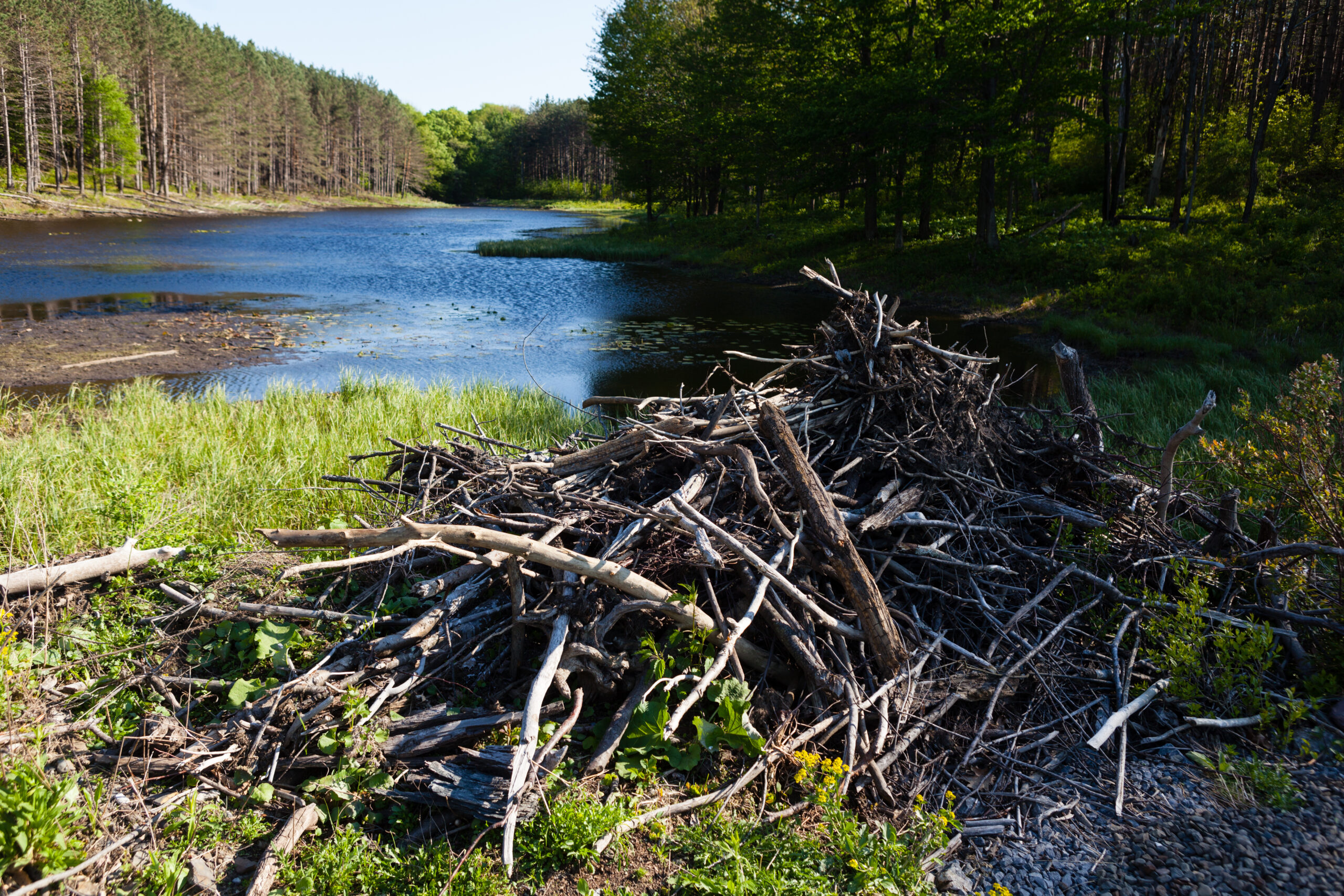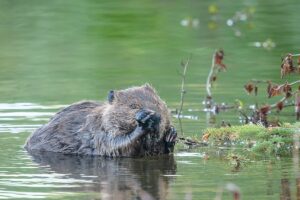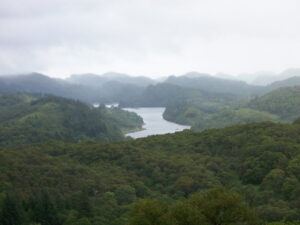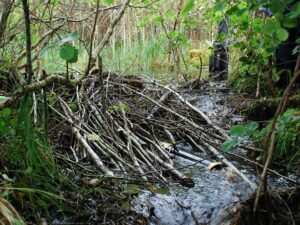April 15, 2023
Effects of Beaver Reintroduction on Scottish Wetlands

When most people think of beavers, the first thing that comes to mind is the incredibly elaborate dam structures they manage to carve from simple pieces of spare timber. What most don’t think about is their role as a keystone species in wetland areas, and the effects of their loss on those environments. Beavers build dams that slow down or block off waterways, creating new ecosystems for species to build themselves around and stimulating the growth of wetland biodiversity1. Eurasian Beavers (Castor fiber) used to be quite prominent in Scottish wetlands before they were hunted to extinction in the 16th century, dealing a significant blow to the biodiversity of these areas that have not since recovered2. The purpose of this research was to determine if their reintroduction to wetland areas through rewilding efforts could restore the abundance of species seen previously and increase overall biodiversity of wetlands in Scotland.


In order to address these concerns, regulations were enacted during the study to manage the beavers’ activities as well as monitoring species that could be negatively affected. These regulations included keeping the beavers within the boundaries of the research area, and “Beaver Management Groups” were formed to monitor the interactions between beavers and the existing species of the wetlands in case issues arose. Despite these protocols having to be issued in order to gain support for the project to move forward, the goal of the study was still to observe both beneficial and detrimental aspects of the beaver reintroductions for future research purposes8.

While the study certainly had its issues, it clearly provided evidence that beavers could offer a solution to reduced biodiversity in Scottish wetlands. Even though it’s true that their dams are made from the destruction of forests alongside the waterways, these effects can be minimized through supervision of their activities by newly established monitoring methods. Since the trial’s conclusion in 2015, new studies have explored the research further to measure the impact on biodiversity through other factors. In 2018, The Royal Society conducted a plant and water beetle survey at similar wetland sites between Örebro and Skinnskatteberg in central southern Sweden, which was similarly being considered for revitalization through beaver reintroduction. After beavers were reintroduced, the surveys found plant species diversity to be 17% higher in environments where beavers were present, and water beetles to be 26% more abundant11. From these findings, it was inferred that beavers reshaped their environments in such a way to increase wetland plants and insects, which would naturally then attract additional species and continue to revitalize these ecosystems.
The studies presented show that beaver reintroduction can have unintended consequences on the ecosystem of wetland communities such as introduction of parasites, but their environmental engineering practices can revitalize biodiversity as well. There is still further research to be done as it is still a relatively unexplored field, but currently beavers stand as an efficient method of combating the rapid biodiversity loss present in UK wetlands12.
- “How Beavers Engineer the Land.” Sustainable Human, September 17, 2022. https://sustainablehuman.org/stories/how-beavers-engineer-the-land/. ↵
- “Eurasian Beaver.” People’s Trust for Endangered Species, November 30, 2016. https://ptes.org/get-informed/facts-figures/eurasian-beaver/. ↵
- Matsubara, Becky. Beaver. Photograph. Flickr. Fairbanks, Alaska, June 23, 2018. https://flickr.com/photos/130819719@N05/29916261218. ↵
- Jones, Simon, and Róisín Campbell-Palmer. Rep. The Scottish Beaver Trial: The Story of Britain’s First Licensed Release into the Wild. Scottish Wildlife Trust & Royal Zoological Society of Scotland, 2014. 1-2 ↵
- Hughes, John. Knapdale Forest. August 4, 2009. Photograph. https://www.flickr.com/photos/jmxhughes/3839639316. ↵
- Rep. UK State of Nature Report 2019. State of Nature, 2019, 29. ↵
- Auster, Roger Edward, Stewart Barr, and Richard Brazier. “Alternative Perspectives of the Angling Community on Eurasian Beaver (Castor Fiber) Reintroduction in the River Otter Beaver Trial.” Taylor & Francis, February 24, 2020. https://www.tandfonline.com/doi/full/10.1080/09640568.2020.1816933. 1252-1270 ↵
- Auster, Roger E., Alan K. Puttock, Stewart W. Barr, and Richard E. Brazier. “Learning to Live with Reintroduced Species: Beaver Management Groups Are an Adaptive Process.” Restoration Ecology, 2023. https://doi.org/10.1111/rec.13899. Matsubara, Becky. Beaver. Photograph. Flickr. Fairbanks, Alaska, June 23, 2018. https://flickr.com/photos/130819719@N05/29916261218. ↵
- Mackie, Patrick. Beaver Dam. August 21, 2009. Photograph. https://commons.wikimedia.org/wiki/File:Beaver_dam_-_geograph.org.uk_-_1452003.jpg. ↵
- Jones, Simon, and Róisín Campbell-Palmer. Rep. The Scottish Beaver Trial: The Story of Britain’s First Licensed Release into the Wild. Scottish Wildlife Trust & Royal Zoological Society of Scotland, 2014. 82, 124 ↵
- Willby, Nigel J., Alan Law, Oded Levanoni, Garth Foster, and Frauke Ecke. “Rewilding Wetlands: Beaver as Agents of within-Habitat Heterogeneity and the Responses of Contrasting Biota.” Philosophical Transactions of the Royal Society B: Biological Sciences 373, no. 1761 (2018): 20170444. https://doi.org/10.1098/rstb.2017.0444. ↵
- “Water.” The Wildlife Trusts. Accessed March 29, 2023. https://www.wildlifetrusts.org/water. ↵
Tags from the story
beaver
Nomination-Environmental-Science
reintroduction
rewilding
Scotland

Byron Cox
My name is Byron Cox and I am an environmental science major from the city of Helotes, Texas. I’m currently a junior with a set graduation date of May 2023 and a desire to aid in city-wide conservation efforts. I often spend my time being with friends or doing volunteer work, though the best times are when I’m doing both! My goal is to do the most I can for the conservation field, and I look forward to a career someday doing just that.
Author Portfolio PageRecent Comments
Matthew Holland
It is one of the best of its kind in it the respective section hands down. I look forward to reading more from them in the future and hope they can write about different topics that would be equally interesting. It will be interesting to see the shift in research related to introducing species back in the wildlife will change thanks to this study.
26/04/2023
8:54 pm
Carolina Wieman
This article was truly intriguing. I knew beavers built elaborate structures out of timber to live in, but never thought about it providing and creating ecosystems for other organisms. At the same time though, they can be harmful to the ecosystem and introduce parasites. I enjoyed reading this and hope they continue to provide more information regarding the environment across other topics.
28/04/2023
8:54 pm
Isabella Lopez
So interesting. Obviously everyone knows beavers build dams but there is so much more to it than that. It fascinating how by them building a dam causes a whole new ecosystem to form which benefits their area and in actuality, themselves. I enjoyed the concern you bring addressing how beavers could benefit or devastate a preexisting ecosystem. That such an interesting idea that researchers would drop a family of beavers in a new place to test how they would affect the area.
24/04/2023
8:54 pm